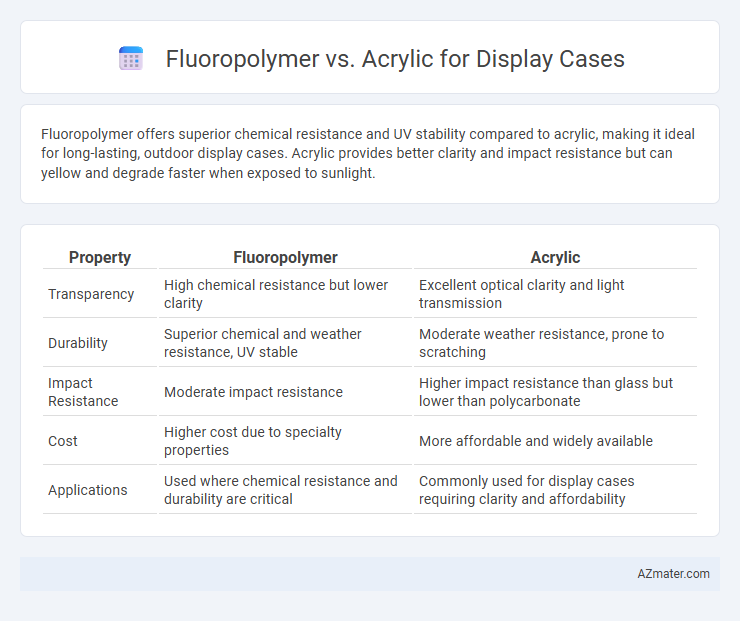Fluoropolymer offers superior chemical resistance and UV stability compared to acrylic, making it ideal for long-lasting, outdoor display cases. Acrylic provides better clarity and impact resistance but can yellow and degrade faster when exposed to sunlight.
Table of Comparison
| Property | Fluoropolymer | Acrylic |
|---|---|---|
| Transparency | High chemical resistance but lower clarity | Excellent optical clarity and light transmission |
| Durability | Superior chemical and weather resistance, UV stable | Moderate weather resistance, prone to scratching |
| Impact Resistance | Moderate impact resistance | Higher impact resistance than glass but lower than polycarbonate |
| Cost | Higher cost due to specialty properties | More affordable and widely available |
| Applications | Used where chemical resistance and durability are critical | Commonly used for display cases requiring clarity and affordability |
Introduction to Display Case Material Choices
Fluoropolymer and acrylic represent two primary material choices for display cases, each offering distinct properties tailored to specific needs. Fluoropolymers provide exceptional chemical resistance, high durability, and UV stability, making them ideal for environments demanding longevity and resistance to harsh conditions. Acrylic, meanwhile, delivers superior clarity, impact resistance, and ease of fabrication, making it a cost-effective choice for visually appealing display cases in controlled environments.
Overview of Fluoropolymer Materials
Fluoropolymer materials, such as polytetrafluoroethylene (PTFE) and fluorinated ethylene propylene (FEP), offer exceptional chemical resistance, UV stability, and high durability, making them ideal for display case applications requiring long-term clarity and protection. Their low surface energy resists staining and facilitates easy cleaning, outperforming acrylic in environments exposed to harsh chemicals or prolonged sunlight. Fluoropolymers maintain structural integrity under extreme temperatures, ensuring display cases remain clear and intact without yellowing or cracking over time.
Key Properties of Acrylic for Display Cases
Acrylic for display cases offers exceptional clarity with light transmittance up to 92%, providing vibrant visibility of displayed items. It boasts high impact resistance, approximately 10-24 times stronger than glass, ensuring durability and safety in high-traffic areas. Additionally, acrylic is lightweight and easily fabricated, allowing for custom shapes and sizes while maintaining a sleek, scratch-resistant surface ideal for long-term use.
Durability Comparison: Fluoropolymer vs Acrylic
Fluoropolymer materials exhibit superior durability compared to acrylic in display cases, offering exceptional resistance to UV radiation, chemical exposure, and extreme weather conditions without yellowing or degrading over time. Acrylic, while lightweight and impact-resistant, tends to scratch more easily and is less effective against prolonged UV exposure, which can cause brittleness and discoloration. For long-term clarity and strength in high-exposure environments, fluoropolymer outperforms acrylic, ensuring sustained protection of displayed items.
Clarity and Visual Appeal Analysis
Fluoropolymer films offer superior clarity and resistance to yellowing, ensuring long-term visual appeal in display cases compared to acrylic, which can become cloudy over time. Acrylic provides excellent initial transparency and is more affordable, but it lacks the chemical resistance and durability of fluoropolymers, leading to potential surface degradation. For applications demanding sustained optical clarity and minimal maintenance, fluoropolymer is the optimal material choice.
Resistance to UV Light and Yellowing
Fluoropolymer coatings exhibit superior resistance to UV light and significantly reduce yellowing over time compared to acrylic, making them ideal for long-term display case protection. Acrylic materials tend to degrade and yellow when exposed to prolonged sunlight, compromising clarity and aesthetic appeal. Fluoropolymers maintain optical clarity and durability under intense UV exposure, ensuring the display case remains visually pristine.
Maintenance and Cleaning Considerations
Fluoropolymer display cases offer superior chemical resistance and non-stick surfaces, making them easier to clean and maintain compared to acrylic, which can scratch and degrade with harsh cleaning agents. Acrylic cases require gentle cleaning with mild soap and plastic-safe cleaners to prevent surface damage and loss of clarity over time. The durability of fluoropolymers reduces maintenance frequency and ensures longer-lasting transparency, ideal for high-traffic display environments.
Cost Comparison of Fluoropolymer and Acrylic
Fluoropolymer display cases typically have a higher upfront cost compared to acrylic due to their advanced chemical resistance and durability. Acrylic cases are more budget-friendly, offering decent clarity and impact resistance at a lower price point. Fluoropolymers provide long-term savings through reduced maintenance and replacement expenses despite the initial investment.
Environmental Impact and Sustainability
Fluoropolymers are durable and chemically resistant but have a high environmental impact due to their persistence and difficulty in recycling, posing concerns about long-term sustainability. Acrylic, derived from polymethyl methacrylate (PMMA), offers better recyclability and lower carbon footprint during production, making it a more eco-friendly choice for display cases. Choosing acrylic over fluoropolymer supports reduced environmental pollution and enhances the sustainability profile of display case materials.
Choosing the Right Material for Your Display Case
Fluoropolymer offers exceptional chemical resistance, UV stability, and durability, making it ideal for outdoor or high-exposure display cases. Acrylic provides excellent optical clarity, is lightweight, and more cost-effective for indoor displays where impact resistance is less critical. Selecting the right material depends on your display's environment, desired longevity, and budget constraints to ensure optimal protection and visibility.

Infographic: Fluoropolymer vs Acrylic for Display Case
 azmater.com
azmater.com